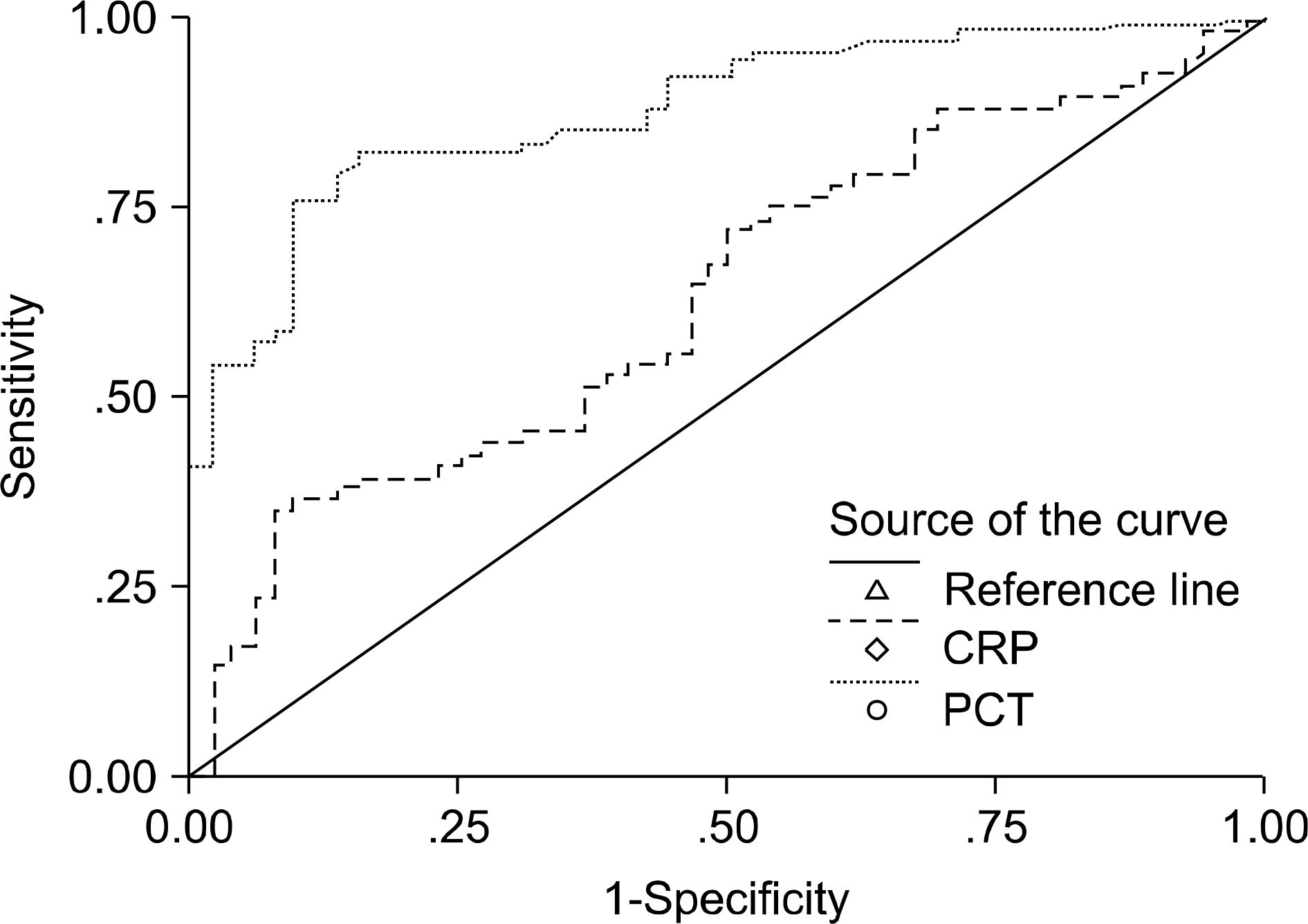Korean J Clin Microbiol.
2011 Mar;14(1):7-12. 10.5145/KJCM.2011.14.1.7.
The Value of Serum Procalcitonin Level for Differentiation between Contaminants and Pathogens in Bacteremia
- Affiliations
-
- 1Department of Laboratory Medicine, Yonsei University Wonju College of Medicine, Wonju, Korea. u931018@yonsei.ac.kr
- 2Department of Infectious Diseases, Yonsei University Wonju College of Medicine, Wonju, Korea.
- KMID: 1449492
- DOI: http://doi.org/10.5145/KJCM.2011.14.1.7
Abstract
- BACKGROUND
Bacteremia is a life-threatening infection, and prognosis is highly dependent on early recognition and treatment with appropriate antimicrobial agents. We investigated the diagnostic performance of serum procalcitonin (PCT) for differentiation between contaminants and true pathogens in blood cultures.
METHODS
Serum PCT, C-reactive protein (CRP) and blood culture were performed for 473 patients between February 2008 and October 2008. We retrospectively reviewed the patients' clinical characteristics and laboratory results based on medical records.
RESULTS
The mean concentration of PCT was significantly different between the two negative and positive blood culture groups (6.45 ng/mL vs 28.77 ng/mL, P<0.001). Procalcitonin levels were found to be markedly higher in those with Gram-negative bacilli (mean+/-SD; 59.58+/-67.00 ng/mL) bacteremia than in those with Gram-positive cocci (mean+/-SD; 17.75+/-42.88 ng/mL) bacteremia (P<0.001). The areas under the receiver operating characteristic curves (95% confidence interval) for PCT and CRP were 0.880 (0.820~0.940) and 0.637 (0.538~0.736), respectively. The use of a PCT level of 2 ng/mL as a cutoff value yielded an 83.6% positive predictive value and a 77.4% negative predictive value for the detection of bacteremia pathogens.
CONCLUSION
Serum PCT is a helpful diagnostic marker for rapidly and accurately distinguishing between contaminants and pathogens in blood cultures.
Keyword
MeSH Terms
Figure
Cited by 1 articles
-
Factors Influencing the False Positive Signals of Continuous Monitoring Blood Culture System
Young Uh, In Ho Jang, Soon Deok Park, Kab Seung Kim, Dong Min Seo, Kap Jun Yoon, Hee Kyoung Choi, Young Keun Kim, Hyo Youl Kim
Ann Clin Microbiol. 2014;17(2):58-64. doi: 10.5145/ACM.2014.17.2.58.
Reference
-
1. Angus DC, Linde-Zwirble WT, Lidicker J, Clermont G, Carcillo J, Pinsky MR. Epidemiology of severe sepsis in the United States: analysis of incidence, outcome, and associated costs of care. Crit Care Med. 2001; 29:1303–10.
Article2. Digiovine B, Chenoweth C, Watts C, Higgins M. The attributable mortality and costs of primary nosocomial bloodstream infections in the intensive care unit. Am J Respir Crit Care Med. 1999; 160:976–81.
Article3. Ibrahim EH, Sherman G, Ward S, Fraser VJ, Kollef MH. The influence of inadequate antimicrobial treatment of bloodstream infections on patient outcomes in the ICU setting. Chest. 2000; 118:146–55.
Article4. Charles PE, Ladoire S, Aho S, Quenot JP, Doise JM, Prin S, et al. Serum procalcitonin elevation in critically ill patients at the onset of bacteremia caused by either Gram negative or Gram positive bacteria. BMC Infect Dis. 2008; 8:38.
Article5. Christ-Crain M and Müller B. Procalcitonin in bacterial infections-hype, hope, more or less? Swiss Med Wkly. 2005; 135(31-32):451–60.6. American College of Chest Physicians/Society of Critical Care Medicine Consensus Conference: definitions for sepsis and organ failure and guidelines for the use of innovative therapies in sepsis. Crit Care Med. 1992; 20:864–74.7. Hur M, Moon HW, Yun YM, Kim KH, Kim HS, Lee KM. Comparison of diagnostic utility between procalcitonin and C-reactive protein for the patients with blood culture-positive sepsis. Korean J Lab Med. 2009; 29:529–35.
Article8. Weinstein MP, Murphy JR, Reller LB, Lichtenstein KA. The clinical significance of positive blood cultures: a comprehensive analysis of 500 episodes of bacteremia and fungemia in adults. II. Clinical observations, with special reference to factors influencing prognosis. Rev Infect Dis. 1983; 5:54–70.
Article9. Müller B, Schuetz P, Trampuz A. Circulating biomarkers as surrogates for bloodstream infections. Int J Antimicrob Agents. 2007; 30(Suppl 1):S16–23.
Article10. Nahm CH, Choi JW, Lee J. Delta neutrophil index in automated immature granulocyte counts for assessing disease severity of patients with sepsis. Ann Clin Lab Sci. 2008; 38:241–6.11. Hunziker S, Hügle T, Schuchardt K, Groeschl I, Schuetz P, Mueller B, et al. The value of serum procalcitonin level for differentiation of infectious from noninfectious causes of fever after orthopaedic surgery. J Bone Joint Surg Am. 2010; 92:138–48.
Article12. Charles PE, Ladoire S, Snauwaert A, Prin S, Aho S, Pechinot A, et al. Impact of previous sepsis on the accuracy of procalcitonin for the early diagnosis of blood stream infection in critically ill patients. BMC Infect Dis. 2008; 8:163.
Article
- Full Text Links
- Actions
-
Cited
- CITED
-
- Close
- Share
- Similar articles
-
- Predictive value of procalcitonin for bacteremia in patients with pneumonia in the emergency department
- Predictive Value of Serum Procalcitonin in Urinary Tract Infection Patients with Bacteremia
- Procalcitonin as a Diagnostic Marker for Bacteremia in Terminal Cancer Patients
- Comparison of the diagnostic performance of initial serum procalcitonin, lactate, and C-reactive protein for predicting bacteremia in female patients with acute pyelonephritis
- Speicies Identification and Antimicrobial Resistance of Coagulase-negative Staphylococcal Bacteremia


